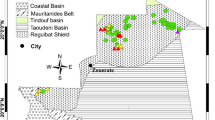Abstract
The mining waste in Al-Amar gold mine is 150 kg a year due to leakage in the extraction process. Studying the textures of gold deposits can be helpful to improve the process of gold extraction. The present work aimed to study the texture, structure, and composition of gold deposits that have different textures and structures using Scanning Electron Microscope (SEM), Electron probe microanalysis (EPMA), and Micro X-ray Fluorescence (µXRF). The ore minerals at different gold deposits were determined and these are pyrite, chalcopyrite, sphalerite, galena, and silica. The contents of Si and Zn in some specific areas are highly indicated to silica and sphalerite minerals, respectively. Additionally, the high contents of Fe and S, as well as some Cu, confirm the presence of pyrite and chalcopyrite minerals. The µXRF technique was used for elemental mapping of S, Si, Ca, Ti, Mn, Fe, Cu, Zn, Pb, and Au. The spectral interference between Zn-Kβ and Au-Lα was found at different pixels and the Au-Lβ was free from interference and used for following the gold in the samples under investigation. The positive correlation between the Au and the elements Zn, Fe, Pb, and Si indicates the existence of the Au element in different minerals as an invisible specks.









Similar content being viewed by others
Change history
21 January 2021
A Correction to this paper has been published: https://doi.org/10.1007/s12665-020-09365-w
References
Al-Hobaib AS, Al-Jaseem QK, Baioumy HM et al (2013) Heavy metals concentrations and usability of groundwater at Mahd Adh Dhahab gold mine Saudi Arabia. Arab J Geosci 6(1):259–270
Aljuhani MSM (2002) Labour’s utilization and labour’s productivity of a gold mine in Saudi Arabia. J South Afr Inst Min Metall 102(5):307–309
International Atomic Energy Agency Laboratories Seibersdorf, XRF Group Seibersdorf (2009) Quantitative X ray analysis system User's manual and guide to X ray fluorescence technique (Technical Report). International Atomic Energy Agency (IAEA), Reference Number: 41115593, IAEA-CMS--21/CD, Vol 41, 168
Gallagher SR (2010) Digital image processing and analysis with imageJ. Curr Protocol Essen Lab Tech 3:1 (A.3C.1-A.3C.24)
Hakim HD (1982) A new contribution to the study of gold-silver mineralization at Mahd Ad Dahab Saudi Arabia. Precambrian Res 16(4):A22
Haschke M, Pfannekuch P, Scruggs B (2000) Ultra-trace analysis by micro X-Ray fluorescence spectroscopy. Adv X-Ray Anal 43:435–441
Haschke M (2014) Laboratory micro-x-ray fluorescence spectroscopy, 1st edn. Springer International Publishing, 55 (XVIII, 356). https://doi.org/10.1007/978-3-319-04864-2
Johnson PR, Kattan FH, Al-Saleh AM (2004) Neoproterozoic ophiolites in the Arabian shield: field relations and structure. Develop Precambrian Geol Else 13:129–162
Khandaker NI, Ahmed M, Hariri MM et al (1997) Microanalytical investigations of gold-bearing rocks from the an Najadi region in Saudi Arabia. Nucl Instrum Methods Phys Res, Sect B 130(1):654–659
Madani A, Harbi H (2012) Spectroscopy of the mineralized tonalite–diorite intrusions, Bulghah gold mine area, Saudi Arabia: Effects of opaques and alteration products on Fieldspec data. Ore Geol Rev 44:148–157
Madani AA (2011) Knowledge-driven GIS modeling technique for gold exploration, Bulghah gold mine area, Saudi Arabia. Egypt J Remote Sens Space Sci 14:91–97
Mahmoud MHH, Awad HM, El-Habib OA (2015) Gold leaching from a Saudi ore by the nonpolluting thiosulfate process. Physicochem Prob Min Process 51(2):59–72
Mahmoud MHH, Awad HM, Altalhi T (2018) Microanalysis study of Al-Amar rock and leaching behavior of its tailings for recovery of gold and silver. Physicochem Prob Min Process 54(2):527–537
Sabir H (1990) Ancient mining and its impact on modern mineral exploration in Saudi Arabia. (BRGM-TR-11–3)
SAMC, 2018. Gold mining, Saudi Arabia mining company, http://www.maaden.com.sa/ar/business/gold. 2018(Accessed date 06 Febraury 2018)
Scruggd B, Haschke M, Herczeg L et al (2000) XRF mapping: new tools for distribution analysis. Adv X-Ray Anal 42:19–25
Shaltout AA, Allam MA, Mostafa NY et al (2016) Spectroscopic characterization of dust-fall samples collected from greater Cairo Egypt. Arch Environ Contam Toxicol 70(3):544–555
Shaltout AA, Ahmed SI, Abayazeed SD et al (2017) Quantitative elemental analysis and natural radioactivity levels of mud and salt collected from the Dead Sea, Jordan. Microchem J 133:352–357
Smolek S, Streli C, Zoeger N et al (2010) Improved micro x-ray fluorescence spectrometer for light element analysis. Rev Sci Instrum 81(5):053707
Sonbul AR, El-Shafei MK, Bishta AZ (2016) Using remote sensing techniques and field-based structural analysis to explore new gold and associated mineral sites around Al-Hajar mine, Asir terrane, Arabian Shield. J Afr Earth Sc 117:285–302
Surour AA, Bakhsh R (2013) Microfabrics and microchemistry of sulfide ores from the 640 FW-E level at the Al Amar gold mine, Saudi Arabia. J Microscop Ultrastruct 1(3):96–110
Surour AA, Harbi HM, Ahmed AH (2014) The Bi’r Tawilah deposit, central western Saudi Arabia: supergene enrichment of a Pan-African epithermal gold mineralization. J Afr Earch Sci 89:149–163
Volesky JC, Stern RJ, Johnson PR (2003) Geological control of massive sulfide mineralization in the Neoproterozoic Wadi Bidah shear zone, southwestern Saudi Arabia, inferences from orbital remote sensing and field studies. Precambr Res 123(2):235–247
Wobrauschek P, Frank B, Zoeger N et al (2005) Micro XRF of light elements using a polycapillary lens and an ultra thin window silicon drift detector inside a vacuum chamber. Adv X-Ray Anal 48:229–235
Zaidi FK, Bassam AM, Hussein MT et al (2012) Hydrological characterization of Mahd Ad Dahab gold mine, Saudi Arabia. Int J Phys Sci 7(22):2935–2943
Acknowledgements
Dr. O. H. Abd-Elkader would like to extend his sincere appreciation to the Deanship of Scientific Research at King Saud University for its funding of this research through the research Group projects no RGP- 306.
Author information
Authors and Affiliations
Corresponding author
Additional information
Publisher's Note
Springer Nature remains neutral with regard to jurisdictional claims in published maps and institutional affiliations.
Rights and permissions
About this article
Cite this article
Shaltout, A.A., Mahamoud, M.H., Abd-Elkader, O.H. et al. Elemental mapping of some collected gold samples from Al-Amar gold mine in Saudi Arabia. Environ Earth Sci 79, 527 (2020). https://doi.org/10.1007/s12665-020-09271-1
Received:
Accepted:
Published:
DOI: https://doi.org/10.1007/s12665-020-09271-1




